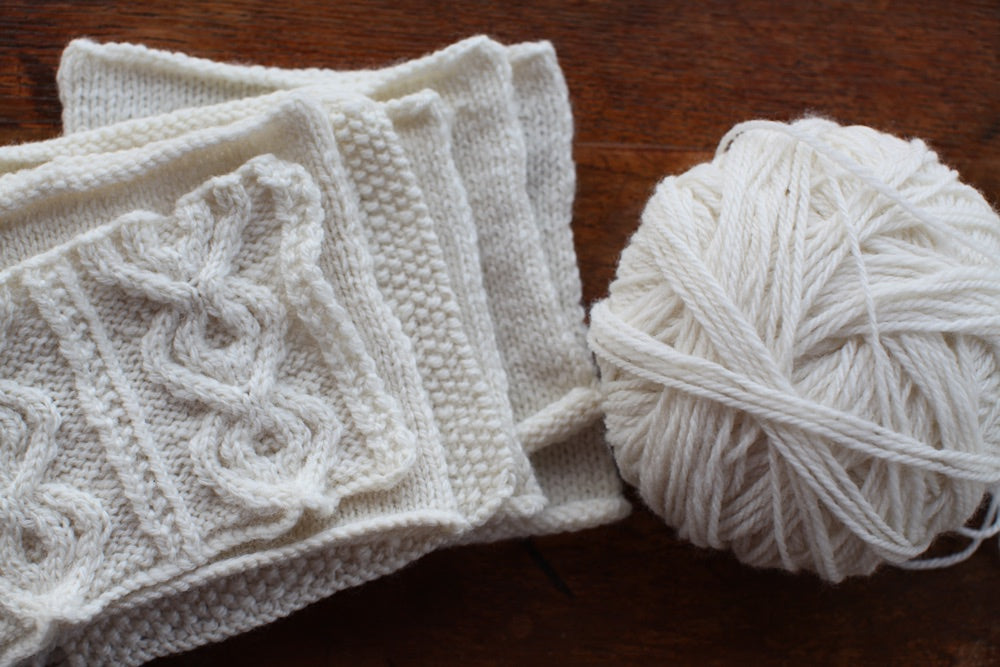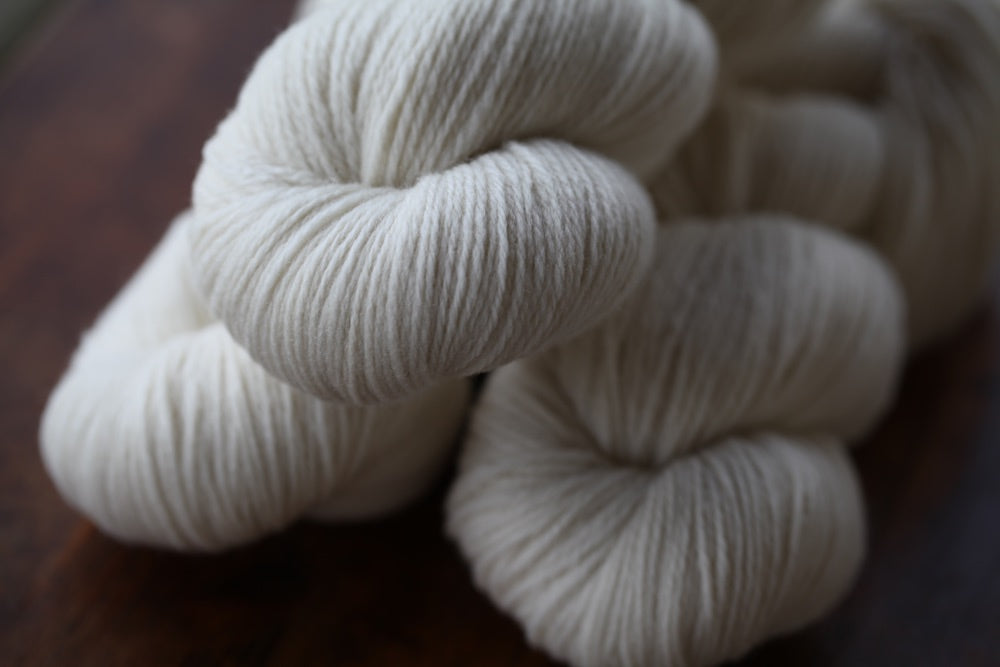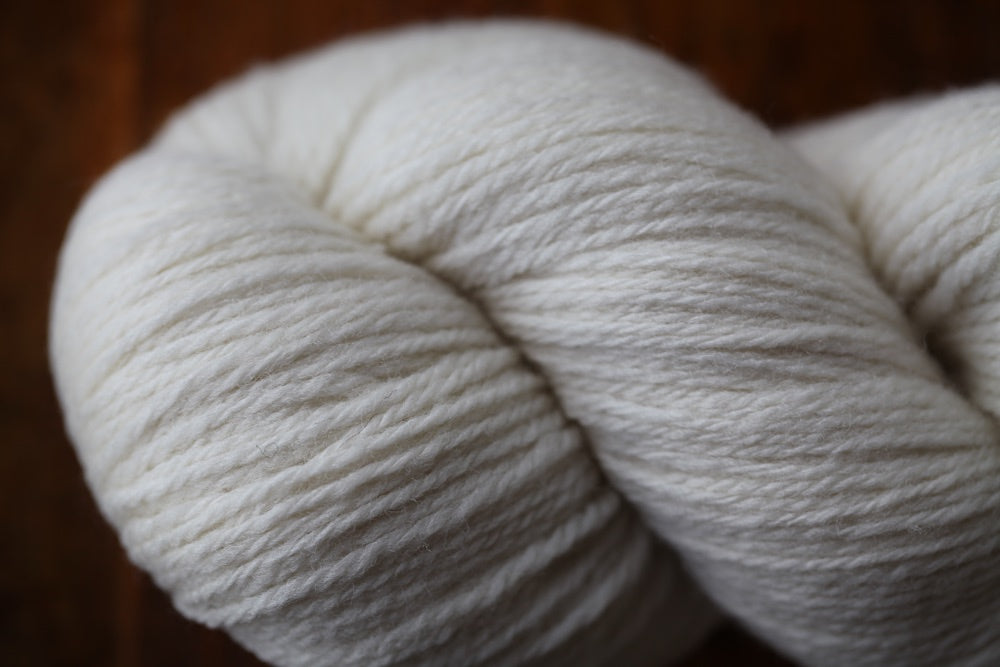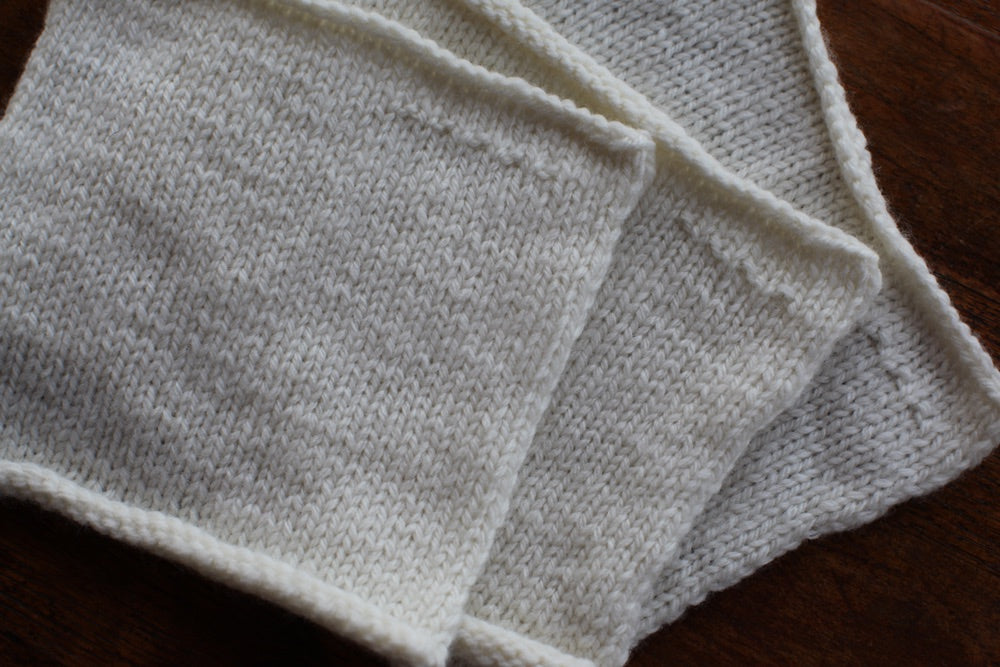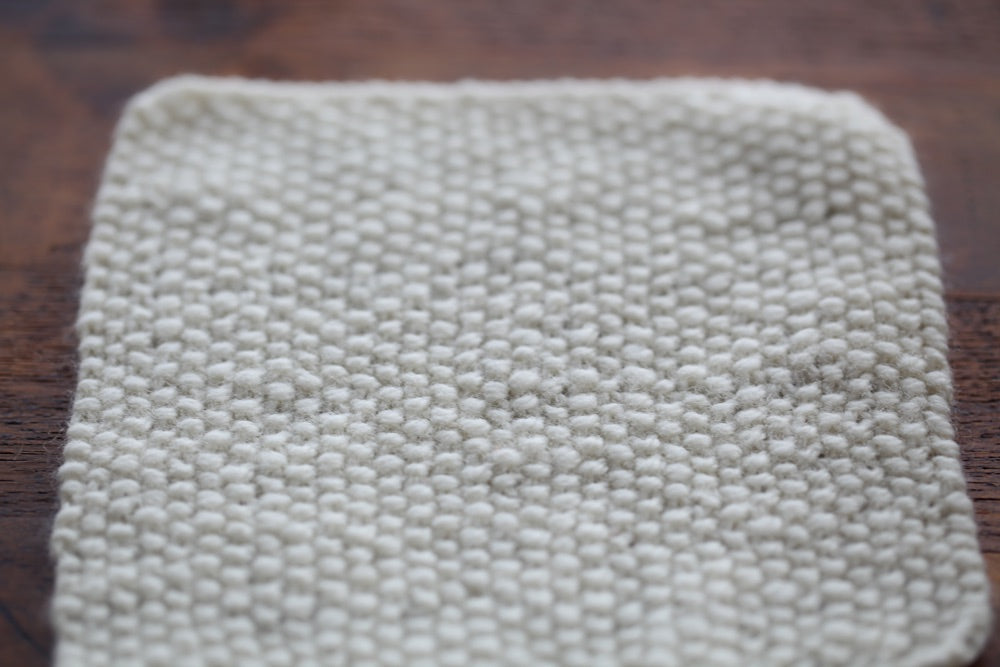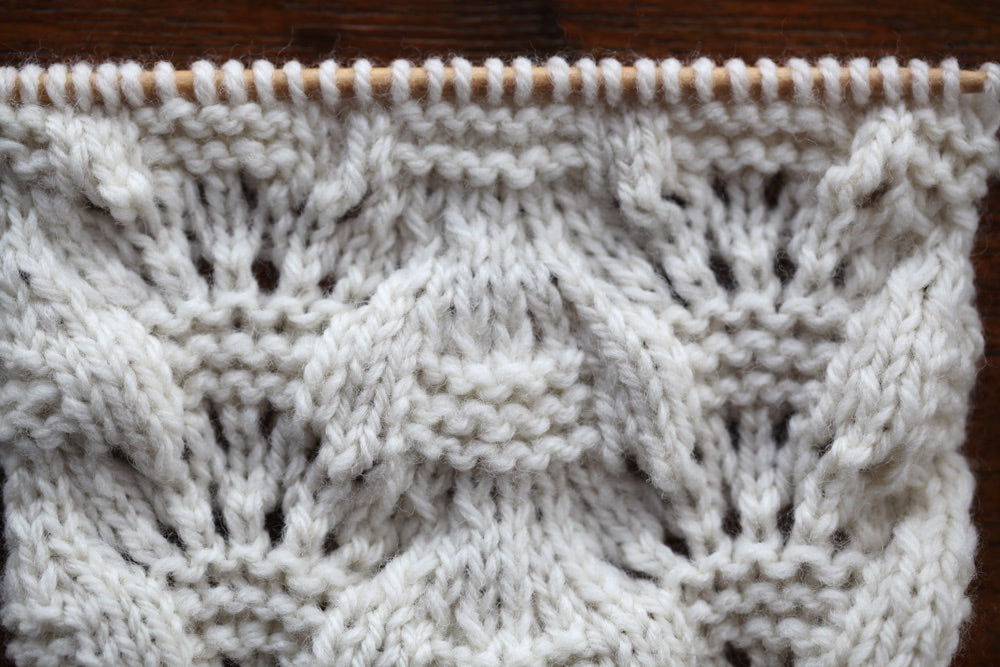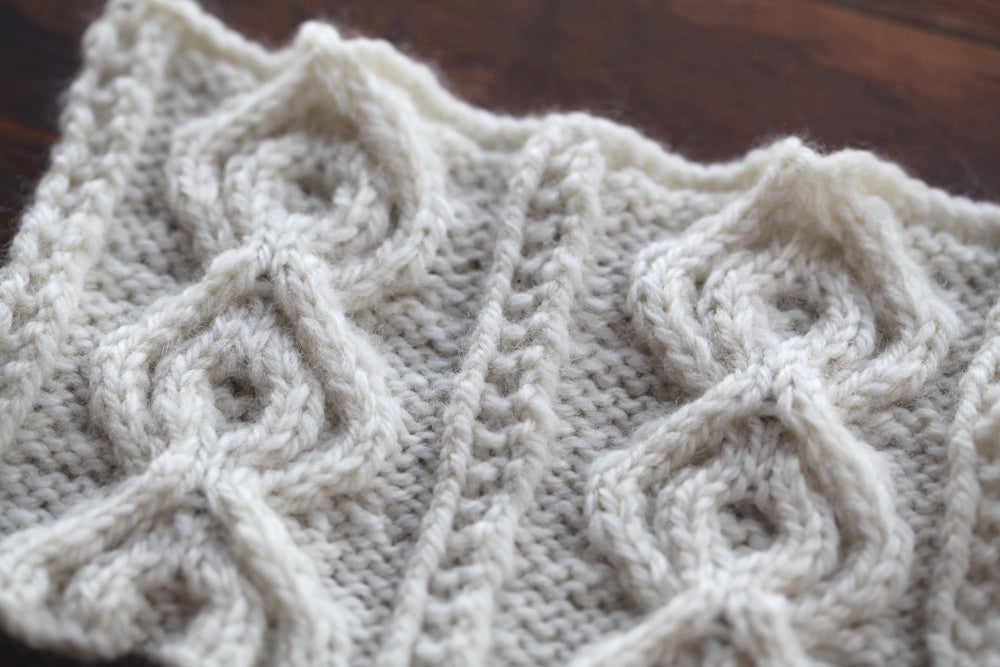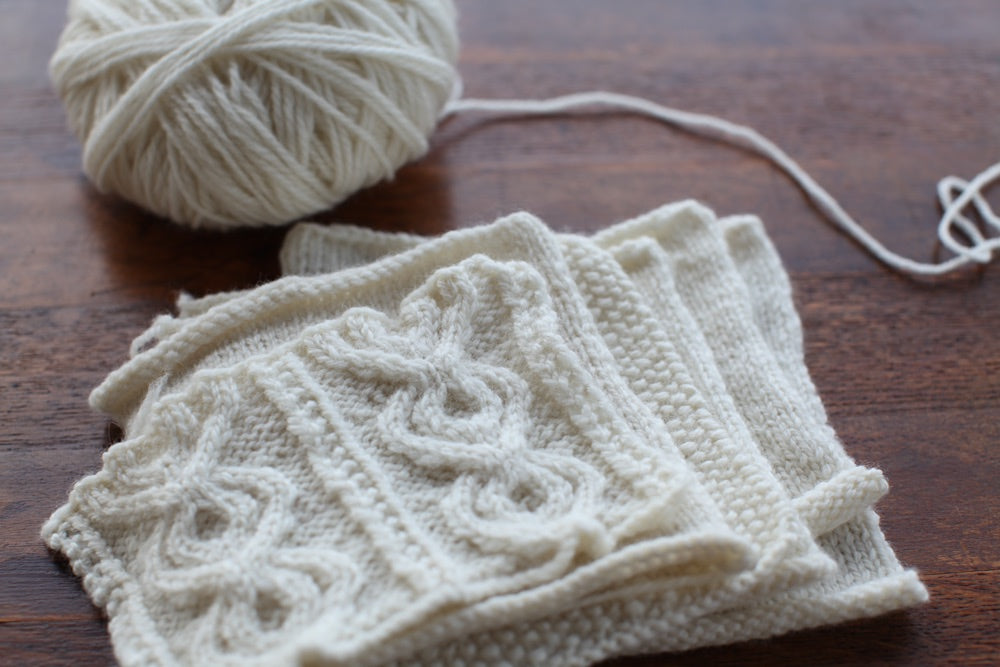Debouillet
$ 28.00
Debou-what?
Debouillet has eluded me for more than a decade. Although the breed is well represented throughout New Mexico and other western wool-producing states, word on the streets (or in the fields?) was that Pendleton had a monopoly on it. Not wanting to tempt people with a breed they'd never touch in commercial yarn, I left Debouillet out of The Knitter's Book of Wool and promptly put it out of my mind.
Fast-forward to September 2015, when my trusted rancher in Montana emailed. They had some Debouillet to spare. Was I interested? Yes!
Quick Facts
This is a combed, worsted-spun, fingering-weight, three-ply yarn made from 100% Debouillet wool. The fibers in this batch average 4 inches with a fineness between 22 and 23 microns.
This yarn is undyed, but a dyed version is in the works next.
Gauge: In stockinette, the ideal gauge range for abrasion resistance and dimensional stability is 6 to 6.5 stitches per inch on US 3-4 (3.25-3.5mm) needles. You have a little more leeway with patterned knits and items that won't endure high abrasion, but the yarn loses much of its liveliness past the 5.5 stitches per inch range.
Put-up: 355 yards (325m)
Skein weight: 100g
Source: Wool from Debouillet sheep raised in Montana. Scoured at Bollman's in San Angelo, Texas. Picked, carded, combed, pin-drafted, spun, and twisted at Kraemer Yarns in Nazareth, Pennsylvania. Skeined, scoured, and twisted into the skeins you see here at the Saco River Dyehouse in Saco, Maine.
Care: Hand wash in warm water with mild soap, let dry flat in a quiet spot away from direct sunlight.
The Breed
The Debouillet breed was developed in southeastern New Mexico by a second-generation sheep rancher named Amos Dee Jones. In the 1920s, Jones began crossing his flock of Rambouillet ewes with Ohio Delaine Merino rams. The goal was to produce a breed with the substantial body size of Rambouillet but with the generous staple and fleece characteristics of Delaine Merino. Armed only with life experience and a 7th-grade education, Jones focused on one trait at a time to develop a breed that, in 1955, was officially recognized by the USDA as Debouillet.
For our purposes, the main thing that makes Debouillet unique is its generous length ranging from 3 to 5 inches. The longer the fiber, the thicker the fiber diameter tends to be, which puts Debouillet on the faintly rougher end of the Merino spectrum. But that also makes it stronger and more durable.
Our Journey Begins
After shearing and skirting, the greasy Debouillet was baled and loaded onto a truck for Bollman in Texas, where it was scoured and baled again. Because I was working with a finewool with a generous staple, I knew I wanted this to be combed, which meant it would be sent to Kraemer Yarns in Nazareth, Pennsylvania, for spinning. Kraemer is the only commercial mill I know of in the U.S. with in-house combing capacity that can work with fibers of this quantity.
Having never worked with Debouillet before, I first asked Kraemer for a sample, so I could try carding, combing, and spinning it myself. After months of experimenting, I finally had an ideal yarn construction for them to replicate.
They worked up a sample, we refined, and in August of this year, the yarn was complete: a combed, worsted-spun, fingering-weight three-ply yarn made from 100% Debouillet wool.
Making the Yarn
Relying on the long staple to provide a baseline of strength, I had the mill spin this yarn with a relaxed ply twist. When knit with sufficient structure (hence the 6 to 6.5 stitch-per-inch gauge recommendation), those airy fibers relax into a well-wearing, cohesive, somewhat ethereal sheet of softness. I showed a swatch to Ken, our wonder carpenter, and he immediately asked if I could knit him a night shirt out of it. "Forget a sweater," he said, rubbing it to his face, "I've gotta sleep in this."
Structually, the yarn's three-ply construction produces an open stitch face and balanced fabric. It also renders any textured stitchwork—from seed stitch to ribbing and cables—with exquisite three-dimensional clarity. And yet, because of that relaxed ply, the clarity is enhanced by a come-hither bloom.
Swatch Notes
Things I've noticed while swatching: The yarn can be frogged (I speak from experience) but with each row that's undone, the yarn grows faintly fuzzier and fuzzier. A more tightly twisted and plied construction could be frogged multiple times, but this yarn, perhaps twice before it starts to show.
When working stitch acrobatics (such as cables without a cable needle or SSKs and K2Togs), you may want to eschew the blunt and go for pointier needle tips. I found myself craving the control and surface friction of wood and bamboo needles.
While the fibers have been combed to remove short and irregular fibers, you may still see a little fiber movement in the initial wear of your garment. Simply put, softness pills. But the longer staple and three-ply construction definitely do their job of enhancing durability, especially in fabrics knit on the tighter edge of the gauge spectrum.
Project Ideas
In addition to that nightshirt for Ken (or anyone else), this yarn is ideal for any type of next-to-skin wear. Pullovers, cardigans, vests, hats, mitts, shawls, scarves, cowls, you name it. For a sweater you won't want to take off, consider Joji Locatelli's Boxy, especially if you wanted to dye your yarn into a hue all your own. (Or you can wait until the dyed Debouillet is ready.) If a luscious, textured wrap is more your style, Joji's Ley Lines would be magnificent.
I'm eager to get going on the dyed shades of Debouillet because they would combine with the natural to make gorgeous versions of Veera Välimäki's Breathing Space or Confetti. Until then, Debouillet would make a very fine companion to any of the brightly dyed yarns used in those patterns.
The yarn purrs in stockinette, ribbing, garter, seed, and pretty much anything else you throw at it. The one thing it won't excel at, however, is traditional lace. That needs a two-ply yarn. But for any patterns that incorporate lace stitches with greater numbers of knits and purls (such as feather and fan), it'll be gorgeous.
What wouldn't I do with this yarn? Probably socks. Not because they wouldn't be heavenly, but because the yarn doesn't have enough of a tight twist for my sock-knitting comfort. OK, maybe a decadent pair of bed socks?
* The gorgeous feather and fan and cable motifs swatched here all came from Hitomi Shida's Japanese Knitting Stitch Bible, translated by Gayle Roehm.

